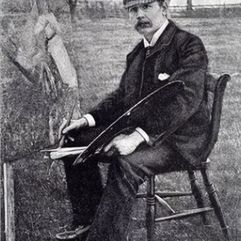

Henry Herbert La Thangue
1859 - 1929
La Thangue studied at Dulwich, and also at the RA schools in London in 1889. He was awarded the gold medal for 'The Pool of Bethesda'. He continued his studies under Gerome at the Ecole Nationale des Beaux-Arts, Paris, influenced by Bastien-Lepage. He settled in Bosham, Surrey in 1890, and later resided at Runckton, Chichester but spent his winters in southern France. His picture, 'The Man with the Scythe', 1896, was purchased by the Trustees of the Chantrey Bequest. He was elected ARA in 1898, and RA in 1912.
Text: CSG CIC Glasgow Museums Collection, 2025








